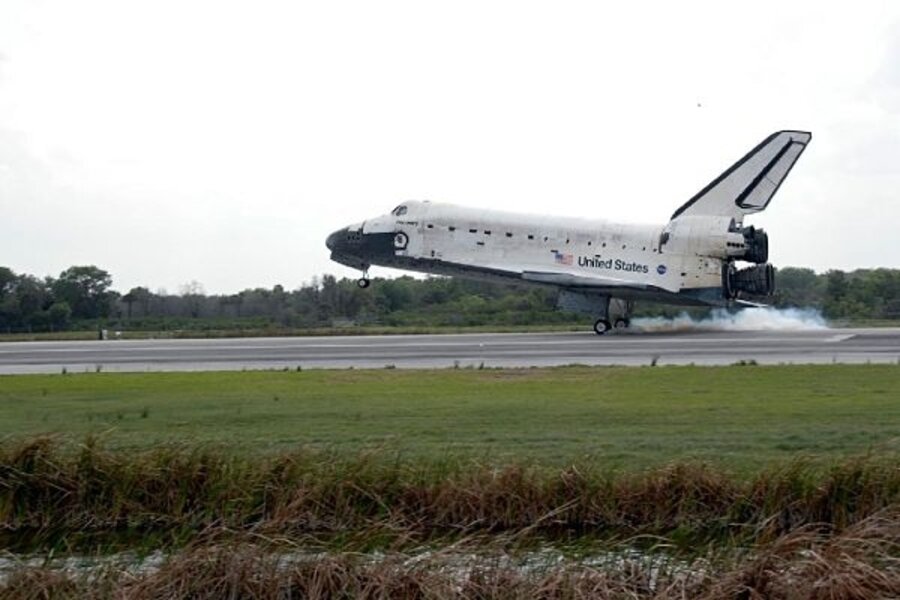A space station that finally looks like a lapel pin!
Loading...
Rubber hits runway in bursts of smoke. A parachute blossoms. One of a fast-dwindling set of space-shuttle missions ends with a crew safely back and a space station finally at full power -- its wing-like solar panels all present, accounted for, and fully spread.
March 28 has been an interesting day in low-Earth orbit. At one point, 13 humans were traveling above their home planet -- only the second time so many were orbiting so high above so small a pale blue dot.
A Russian Soyuz craft arrived at the station today with its three-person crew -- including a space tourist up for his second journey. The station had its partial complement of three people. And the shuttle was still on orbit with another seven people.
Not quite Grand Central Station. But you've gotta start somewhere.
To William Gerstenmaier, NASA's associate administrator for space operations, this was a landmark mission. As the day ended, he said, 'If you look at the space station, it looks like the pins on our lapels" -- close enough to completion to finally take on the look of artist renderings and tourist curios that have graced NASA's gift-shop shelves for more that a decade.
"It's an amazing time and it was an amazing mission," he enthused.
For the earthbound, the mission began with a spectacular evening launch March 15, visible up and down the US Eastern Seaboard. The following Tuesday, after the shuttle had docked to the station, the pair put on a good show for earthlings again.
Here in New England, for instance, the pair traced an arc high across the late-dusk sky. The pass lasted for six minutes. The spacecraft shone brilliantly, lit by a sun that had long since slipped below the horizon up in these parts.
For the shuttle Discovery, it's back to the processing building and a 101-day turn-around for its next mission.But NASA officials note that the Kennedy Space Center will be hopping in the meantime. Next Tuesday, the shuttle Atlantis heads for the launch pad for a May 12 trip to the Hubble Space Telescope. April 17, Endeavour rolls out to a second shuttle launch pad, ready for use as a rescue craft if Atlantis gets into trouble.
Assuming all goes well with the Hubble mission, Endeavour will undergo preparations for delivering additional pieces of the Japanese laboratory at the space station. And in July, NASA is scheduled to launch Ares 1X, a test version of the rocket designed to replace the shuttles as the country's taxi to orbit.
The US space program's direction remains a subject of debate among space enthusiasts in Congress, in industry, and among a hardy band of special interest groups.
For much of the country, space exploration seems to be of interest, but only in passing -- even when the country isn't consumed by an economic crisis. NASA is still without a new administrator or even a nominee. And President Obama has offered the view that the agency is adrift.
Yet any misgivings he may have about the agency's course didn't hold him back from making hail-to-the-station phone call to the orbiting crews. The call "was a bit of a surprise," acknowledges Lee Archambault, the mission commander. "I certainly didn't know about it before the mission."
So for 12 days, 19 hours, 29 minutes, and 33 seconds -- and 5.3 million miles -- anyone who opted to pay attention shared in a small way in a remarkable out-of-planet experience.
For all the griping in some circles about the boring nature of humans still circling in low-Earth orbit, even that modest location can still captivate. Even a president. At least for a few minutes.
Here's a slightly sped-up version of the video shuttle astronauts took as they flew around the space station before heading home. Thanks to nasawatch.com for highlighting it.





